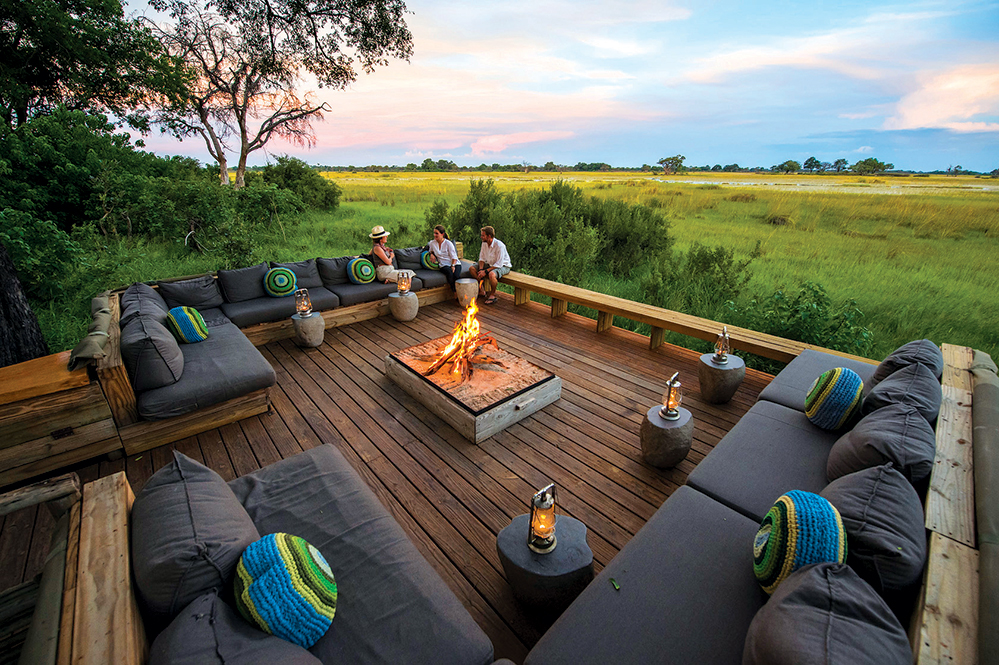Botswana Serves Up Nature in the Raw
Nov 01, 2016

The launch pad for most tourists aiming for the high end of what Botswana has to offer them is Maun Airport. The airport is old, disorganised and hot, though not oppressively so. Harried airline staff try to placate passengers, many of whom are in Africa for the first time and unused to such chaos. Yet the airport buzzes with the enthusiasm of the milling safari tourists, who are raring to get out into the bush.
The safari tourists are most likely to be heading for the Okavango Delta, Botswana’s greatest attraction. The delta is a UNESCO World Heritage natural wonder. It is a vast, inland expanse of permanent marshland and seasonal floodplain, covering more than 2 million hectares, surrounded by desert. Its crystal-clear waters never reach the sea. The delta’s annual cycle begins when the summer rains fall some 1,600 kilometres away in Angola, filling the watercourses that drain into the delta several months later during the winter. Only a few fortunate visitors get to see the flood come in during any one year, as the number and capacity of the camps that accommodate them is strictly limited, and almost all the camps are very expensive.

My itinerary, arranged by A2A Safaris, takes me to three Wilderness Safaris camps. As the tiny Cessna that takes me on the first stage putters aloft, I’m struck by how dry and dusty the gateway to the delta is, its settlements scattered around amid the barren fields. A few minutes later the plane takes me over a buffalo fence, which marks the delta’s boundary. The fence is thousands of kilometres long, running north to south and east to west. It’s a man-made barrier to keep cattle and wildlife from mixing, but it is controversial, because the barrier is sometimes detrimental to both sets of animals.
Below me, the landscape changes dramatically. Desert gives way to limpid pools and snaking channels glistening in the sun. The stretches of water are surrounded by carpets of grassland and clumps of bushes. It’s a scene that extends as far as my eye can see – where a blue-green tint marks the convergence of land and sky. I spot a procession of elephants, their forms clearly discernible as they search for water in the midday heat.

Water brings life, and in the delta, thousands of elephants and other wild animals, many belonging to endangered species, flock to this magnificent oasis to drink and feed. Antelope, buffalo, giraffe, wildebeest and zebra are plentiful. They, in turn, draw lions, leopards, cheetahs and wild dogs. The abundance of prey means plenty of predatory action, which makes for thrilling theatre. Twitchers are also in for a treat, the delta harbouring more than 400 species of bird.
My first stop is Seba Camp, which cosies up to a lagoon in the west of the delta. As I arrive, a big bull elephant stops to make a meal of a tree near reception, and then lumbers away. The family-friendly camp consists of eight canvas tents on raised timber floors giving onto wooden decks. It is comfortable, though simpler than the other camps I subsequently visit. There is no time to settle in, however, and soon I find myself in the back of a Land Cruiser, scouting for game.

Sightings come thick and fast as our open-top vehicle splashes through shallow waterways. A spotted hyena basks in the late-afternoon sun, mongooses snarl angrily at us and buffalo dare us to encroach on their patch. Our guide spots two male giraffes fighting and we speed through the thicket to get close. The giraffes battle with their elongated necks, bashing into each other and making thumping sounds like barbell weights hitting a punching bag. These creatures are not as gentle as they seem, each drawing blood from the other.
On another sortie, I see a pride of lions ripping into the innards of a freshly killed buffalo. I’m astonished by how close we get, my guide inching our vehicle forward to within metres of the fearsome beasts. Even more amazing is how little they are bothered by our presence, as long as we stay quiet and avoid sudden movements – which we dutifully do. It is a brilliant photo opportunity, and I snap away to my heart’s content as the lion gnaws away to his heart’s content.

A more tranquil experience is my sunset cruise in a mokoro. A mokoro is narrow, shallow-draught canoe poled along like a punt. It is the traditional form of transport in this waterlogged region. I sit and my boatman stands, deftly balanced as he steers us through a jungle of reeds and water lilies, our vessel gliding silently through water so pristine that I’m tempted to dive in – until fear of being attacked by a hippopotamus or crocodile dispels the temptation. The atmosphere is enchanting. The sun blazes orange, and then is extinguished, and the frogs and birds break into their evening chorus in celebration.
Our next camp – Duma Tau, one of the most popular in Botswana – is on the Linyanti River. The Linyanti River swamp complex is not part of the Okavango Delta, but lies to the north, a short flight away. It sits on a geological fault that causes unpredictable shifts in the flow of water through the region. An important area for migratory fauna, it is reputed to be more densely populated by elephants than anywhere else in the world. Huge numbers of other kinds of wildlife are also found there.

The camp consists of 10 commodious tents lining the river. The camp is a study in safari chic. It has representations of old maps of Africa printed on screens and cushions, brass lamps, whirring fans, and studded leather and canvas trunks, evoking the bygone era of intrepid exploration of a continent unknown to outsiders. Nets for tent walls and doors allow views from the hugely comfortable bed, and even from the bathroom, of the scene outside – views of the river, the plains and, in the far distance, Namibia.
Tempted as I am to chill out on the deck outside my tent, I go instead for a cruise on a raft. My timing is perfect. My guide spies a parade of over a dozen elephants approaching the riverbank downstream. One by one, they enter the water and swim across, their trunks raised like periscopes and their wrinkled hides glistening golden in the fading light of day. We watch in awe, gin and tonics in hand.
The next day brings one of the most exciting encounters: with wild dogs, also known as African painted dogs because of their mottled fur. They are much admired by wildlife enthusiasts and their guides. These elusive animals are among the most intelligent and efficient hunters on earth, killing a far higher proportion of their quarry than lions or leopards. Yet the species is in danger of disappearing. When the call comes through on the radio that a pack has been located, my guide and I race to catch a glimpse of the dogs. They are still where they were when first spotted, but the sight of them is something of an anti-climax: they are just dozing.

It seems the best has been saved for last, and I end my trip back in the Okavango Delta, at Vumbura Plains, the most luxurious of the camps on my itinerary. It comprises two sets of modern pavilions, 14 in all, built in a sort of Scandinavia-meets-Africa style. Each pavilion is as big as a house, with transparent screens all around, soaring ceilings, a platform bed, a sunken lounge, showers inside and out, a huge viewing deck and a private plunge pool. Vumbura Plains also gives me the most spectacular encounters with wildlife on my trip. These encounters include another sighting of wild dogs. This time the pack includes a litter of pups, only a few weeks old, playing outside their den under the watchful eye of the alpha female, which ushers them inside at the first hint of danger.
Nearby, but safely beyond the reach of the dogs, red lechwe leap gracefully across streams and a herd of sable antelopes, with glossy tufts of fur and majestic curved horns, graze in the open. My guide and I track a lion for miles as it searches for its mate, its rumbling, throaty growl causing me to break out in goosebumps. A lone leopard gingerly crosses a marsh in search of drier ground, its tail curled aloft lest it get wet.

Afloat again, we speed around a stunning lagoon and along papyrus- lined channels carved by elephants and hippopotamuses, my hand trailing in the cool, pure water. I take a final mokoro cruise at sunset, and my attention is drawn to rare slaty egrets and tiny reed frogs, no larger than my thumbnail.
The highlight at Vumbura Plains turns out to be what I might describe prosaically as dinner and a cultural show, were it not so ineffably superior to other such events elsewhere. Camp staff in traditional costume perform around a bonfire. The atmosphere is electric. It’s a drum-thumping, hip-shaking, foot-stomping, hand-clapping, all- dancing all-singing affair loud enough to lift the roof off the heavens. The rituals and performances are intrinsic parts of the lives and culture of the local people, and the show is put on as much for their gratification as for the entertainment of the well-heeled visitors. I am privileged to witness it.





























